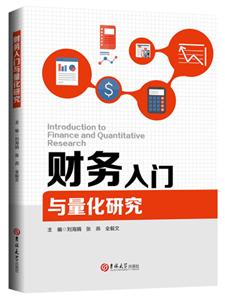有劃線標(biāo)記、光盤(pán)等附件不全詳細(xì)品相說(shuō)明>>
-
>
以利為利:財(cái)政關(guān)系與地方政府行為
-
>
立足飯碗 藏糧于地——基于中國(guó)人均耕地警戒值的耕地保護(hù)視角
-
>
營(yíng)銷(xiāo)管理
-
>
茶葉里的全球貿(mào)易史(精裝)
-
>
近代華商股票市場(chǎng)制度與實(shí)踐(1872—1937)
-
>
麥肯錫圖表工作法
-
>
海龜交易法則
財(cái)務(wù)入門(mén)與量化研究 版權(quán)信息
- ISBN:9787569249446
- 條形碼:9787569249446 ; 978-7-5692-4944-6
- 裝幀:一般純質(zhì)紙
- 冊(cè)數(shù):暫無(wú)
- 重量:暫無(wú)
- 所屬分類(lèi):>>
財(cái)務(wù)入門(mén)與量化研究 本書(shū)特色
國(guó)際會(huì)計(jì)專(zhuān)業(yè)一線教師,本著“立足高職,服務(wù)高職、培養(yǎng)國(guó)際商務(wù)人才”的宗旨,編寫(xiě)了此書(shū)。本書(shū)根據(jù)國(guó)際會(huì)計(jì)專(zhuān)業(yè)人才培養(yǎng)目標(biāo),以會(huì)計(jì)學(xué)的基本理論為出發(fā)點(diǎn),旨在培養(yǎng)國(guó)際會(huì)計(jì)專(zhuān)業(yè)學(xué)生,使之成為既有系統(tǒng)的國(guó)際會(huì)計(jì)專(zhuān)業(yè)理論知識(shí),又有實(shí)際工作經(jīng)驗(yàn)與能力的商業(yè)人才。 本書(shū)特點(diǎn):實(shí)用性強(qiáng)、學(xué)練結(jié)合、 簡(jiǎn)明扼要,又一切從讀者方面考慮,深入淺出、循序漸進(jìn)。
財(cái)務(wù)入門(mén)與量化研究 內(nèi)容簡(jiǎn)介
本書(shū)根據(jù)專(zhuān)業(yè)教師的雙語(yǔ)教學(xué)目標(biāo),旨在將會(huì)計(jì)專(zhuān)業(yè)學(xué)生培養(yǎng)成為國(guó)際專(zhuān)業(yè)人才,既通曉國(guó)際會(huì)計(jì)專(zhuān)業(yè)理論知識(shí),又具備會(huì)計(jì)實(shí)際工作經(jīng)驗(yàn)與能力。本書(shū)分為兩大部分,**部分為財(cái)務(wù)導(dǎo)論,包括制基本的管理會(huì)計(jì)信息、財(cái)務(wù)信息使用者等,第二部分為定量研究,包括數(shù)據(jù)收集、項(xiàng)目管理理念等。
財(cái)務(wù)入門(mén)與量化研究 目錄
Part 1 Introduction to Finance 001
Chapter 1 Sources of Finance 005
Chapter 2 Prepare Basic Management Accounting Information 024
Chapter 3 Prepare Basic Financial Accounting Information 045
Chapter 4 Users of Financial Information 070
Chapter 5 Assess the Performance and Financial Position ofa Business 078
Chapter 6 Project Appraisal 118
Part 2 Quantitative Research 131
Chapter 1 The Collection of Data 133
Chapter 2 Data Presentation 181
Chapter 3 Researching Your Assignment 215
Chapter 4 Research Proposal 252
Chapter 5 Writing Your Assignment 262
Chapter 6 Project Management Concept 295
財(cái)務(wù)入門(mén)與量化研究 節(jié)選
1.5 Sources of Short-term Finance 1.5.1 Bank Overdraft Bank account holders can prearrange with the bank to draw cheques to a greater valuethan the actual balance in the account. Customers are charged interest on the size of theoverdraft. Bank charges will also apply where an overdraft limit has been exceeded. Bank overdrafts are a fairly cheap form of finance with the added advantage of flexibility.In some cases a small overdraft facility may be offered free of charge. 1.5.2 Short-term Loan Bank customers can formally arrange to borrow a sum of money for a specified period oftime, usually for a specific purpose. Repayments are made monthly, together with an interest charge. 1.5.3 Trade Credit Businesses commonly purchase raw materials or inventory for resale and pay for them later. By delaying payment for inventory, cash is made available for other uses. Using trade credit may appear to be an interest free way of raising finance, however, by delaying payment for goods customers may forfeit discounts. Delayed payments can also lead to poor relations with suppliers. 1.5.4 (Debt) Factoring For a fee, debt collection agencies will buy a company’s debts and then attempt tocollect the money themselves. This is very useful for a company that is experiencing cashflow problems as they can receive a large percentage of their debts in cash before these debtsare due for payment. This can mean a company can receive up to 80% of outstanding cashimmediately without the associated costs of debt collection. The remaining cash may bereceived later (minus the debt collection agency’s fee) once the debtor pays. ? Company sells its debts. ? Factoring company pays all cash for trade sales. ? A fee is charged. 1.5.5 Hire Purchase The cost of an asset may be spread over a period of time whereby a company makes aninitial down payment followed by regular fixed instalments with the additional payment of HPinterest. This source of finance would normally be for a specific asset that would remain theproperty of the lender until the last payment has been made. This could also be a medium termsource of finance, in which case it is referred to as Instalment Credit. 1.6 Sources of Medium-term Finance 1.6.1 Medium-term Loan Medium-term loans are similar to short-term loans, however there is greater flexibility ofconditions. For example: ? Repayments may not begin until after a certain period has passed. ? All repayments may be deferred until a specific future date. ? Interest rates may be fixed or variable or adjusted at regular intervals. With such agreements, as well as interest, an arrangement fee will apply and the loan may be secured on the company’s assets. 1.6.2 Leasing Where a firm does not wish to purchase an asset outright, they may rent it instead from a leasing company. The user does not own the assets, however an option to buy the assets outright once the leasing term is completed may be available. Other advantages include: increased efficiency when equipment is only required occasionally, more up-to-date equipment, reduced maintenance costs. However leasing is more expensive than outright purchase over a long period of time and loans cannot be secured on assets which are leased. 1.6.3 Syndicate Loan Where a larger sum of money is involved or if the customer carries a risk, a group of banks will contribute towards a single loan. 1.6.4 Instalment Credit This source of finance is as per hire purchase but the agreed period is longer.
- >
詩(shī)經(jīng)-先民的歌唱
- >
上帝之肋:男人的真實(shí)旅程
- >
史學(xué)評(píng)論
- >
姑媽的寶刀
- >
小考拉的故事-套裝共3冊(cè)
- >
中國(guó)歷史的瞬間
- >
【精裝繪本】畫(huà)給孩子的中國(guó)神話
- >
企鵝口袋書(shū)系列·偉大的思想20:論自然選擇(英漢雙語(yǔ))
-
¥24.4
¥78
















